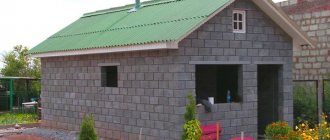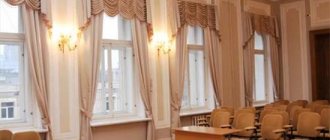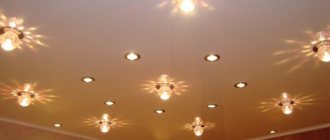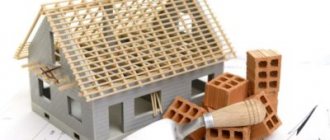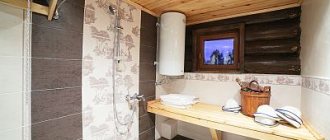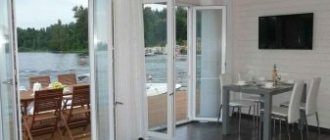When building a sauna on a site, it is necessary to maintain the distance from the house to the bathhouse in accordance with the prescribed SNiP (SP), SanPiN and fire safety standards. Firing a steam room can cause a fire both in SNT and on private housing construction lands. Based on this, the distance from the bathhouse to the house and other buildings on the site must be observed by law in 2021.
On a site in the private sector
Rules for building a sauna in the house
For many people, the sauna has become a favorite place where they can relax after a long day of work, warm up in bad weather and get health benefits. It’s good if the plot is large enough and you can allocate space for the construction of a separate sauna. What about those who have a limited number of acres, but really want to pamper themselves with dry steam? The construction industry has found a popular solution to this problem: an in-home sauna. We will devote this article to a detailed discussion of this issue.
House with sauna: advantages
The project of a house with a bathhouse has become very popular among customers for the following objective reasons.
- Does not require a separate plot of land. Since the cost of the treasured acres is quite high, it is not worth spending it on the construction of a large-scale project.
- Combining a sauna with a house significantly reduces the cost of its installation, because all that is required is work on thermal insulation of the building structures of the room, installation of equipment for the sauna and a good exhaust system. In the case of a free-standing sauna, the estimate will be much more expensive due to the construction of the sauna box, the roof and the laying of communications.
- The purely practical advantage of such a sauna is that using the excess heat generated during the combustion process, you can heat the premises.
- Of course, comfort of use. How convenient it is to heat a sauna without leaving home. If the house has a swimming pool, then it is worth placing a sauna in close proximity to it. How wonderful it will be to refresh yourself after a steam bath in cool water!
Bathhouse at home: dangerous disadvantages
The project of a house with a sauna has only two drawbacks, but they are quite significant.
- The possibility of a fire is the main disadvantage, because a house with a bathhouse becomes a fire hazard. If the rules for lighting the stove are violated, a fire may occur. A burning sauna can cause damage to the rest of the house when a freestanding sauna only burns itself out.
- A sauna is a room in which excess humidity is created. With an incorrectly designed ventilation system, moisture spreads to other rooms, contributing to the occurrence of dampness and rotting processes.
Sauna at home: rules for safe comfort
It is worth noting that these disadvantages can be successfully compensated for by ordering a house project with a bathhouse to specialists. They will design a building that is both well ventilated and safe from a fire point of view. If you decide to convert one of the rooms in your house into a sauna, strictly monitor compliance with fire safety rules:
- In the sauna it is necessary to ensure a single air exchange by organizing the ventilation of the supply and exhaust cycle.
- When installing saunas in buildings with fire resistance types I, II and III, it is necessary to separate these rooms with fire-resistant partitions of the 1st type and ceilings of the 3rd type of fire resistance. All standard designs of cottages and houses Z500 belong to the second group of fire resistance, as they are designed using stone materials.
- It is prohibited to arrange a steam room for more than 10 people.
- The stove for heating the sauna must be manufactured in a factory and automatically turn off the power when operating for 8 hours without breaks.
- To avoid rapid fire, it is necessary to use only hardwood for interior decoration.
- It is necessary to maintain a minimum distance of 20 cm from the walls of the steam room to the electric oven.
- Where the stove is installed on the ceiling, it is necessary to provide a heat-insulating shield made of non-combustible materials, maintaining a distance of 5 cm between the shield and the ceiling finish.
- It is imperative to install dry pipes (perforated water pipes) connected to the public water supply system to extinguish a fire in the steam room.
These requirements are specified in the following documents: Manual for SNiP 21-01-97, called “preventing the spread of fire”; SNiP 21-01-97 “Fire safety of buildings and structures”; NPB “Individual residential buildings. Fire safety requirements" No. 106-95.
What material is best to build from?
Many owners of suburban areas dream of having their own bathhouse. But building it according to all the rules is not at all easy. Due to the presence of a furnace, very stringent requirements are imposed on such buildings. When choosing the base material, you need to rely not only on the price and ease of building a home sauna, but also take into account compliance with the conditions inside the steam room.
Baths are often built from wood or brick. These materials are capable of providing high levels of thermal insulation. They do not emit toxic compounds when heated and are highly resistant to humid environments. Each type has its own characteristics and is used for the construction of a steam room, taking into account its size, number of floors, and climatic indicators.
From wooden beams
The wooden structure retains heat well and quickly removes toxins and gases. The light weight of the bath allows the installation of building materials without additional reinforcement of the foundation. The type of rock gives the structure special characteristics. Among the popular varieties are the following:
- Pine. The budget material has an attractive appearance, light color and sufficient moisture resistance. Due to the release of resin when heated, the formation of mold is slowed down. It is not recommended to decorate the steam room with pine, since when heated, thick sap is released, which can easily burn the skin.
- Linden. Due to low moisture resistance, only specially processed varieties are suitable for making baths. A material with excellent heat resistance begins to darken after a couple of years.
- Aspen. The density of golden rock only increases over time, making it difficult to process and repair. The waterproof material retains heat well, but is not included in the budget category.
- Alder. Boards with a beautiful reddish tint practically do not shrink, but quickly darken when in contact with moisture.
Made of brick
The main advantage of brickwork is durability. A bathhouse made of such material will easily last up to 20 years. There is no need for additional cladding, since the brick itself looks attractive. Also an undeniable advantage in favor of this type of bathhouse will be its non-flammability, the absence of fungus and mold on the walls.
The considerable weight of the brick requires the installation of a strip base under the steam room. This increases the duration of construction work. First you need to pour a concrete foundation, wait for it to completely harden, then install the brick walls and roof in stages.
You can build a bathhouse from red or gas silicate bricks. For any of the types, it will take at least 1 hour to warm up. The building will also need to be insulated from the inside. Fireclay bricks are used to lay out the hearth and other places in contact with open fire.
Brick does not allow air to pass through, so when building a bathhouse you need to take care of good ventilation.
From foam blocks
Affordable material will allow you to quickly build a strong structure. Cellular blocks of regular rectangular shape are processed in autoclaves, which gives them all the necessary characteristics. The low weight of the elements allows the construction of a bathhouse structure without additional strengthening of the foundation. The blocks are cut into pieces with a simple hacksaw. Installation takes place using a special cement adhesive.
The disadvantages include the hygroscopicity of the material. But special treatment makes it possible to reduce the transfer of heat to the outside. Foam blocks of the lowest density and thermal conductivity are suitable for building a bathhouse.
Bathhouse in the house or as a separate building: pros and cons
Not a single land owner will refuse his own Russian bathhouse. At the first stage of planning a building, an important question arises - to build a bathhouse directly in a private house, as part of it, or as a separate building. Let's discuss this topic together, highlighting the pros and cons of solutions.
Let us immediately clarify that we are talking about a real Russian bathhouse, which is heated by a wood-burning stove in a white manner. It is much easier to build a sauna into a house or even an apartment.
First, let's look at the advantages of locating a bathhouse directly in a private house:
- Savings on construction. It is cheaper to build a bathhouse and a house on the same foundation, under one roof, than to build two separate buildings;
- Saving space on the site. A free-standing sauna will take up more space than just a steam room installed in the house;
- Savings on operation. The bathhouse will have the same heating system as in the house, lower maintenance costs and maintenance of the facade;
- Save time. There is no need to leave the house to check whether the steam room has warmed up. Cleaning the bathhouse is also easier - there is no need to drag the vacuum cleaner around the area, it can be combined with a general cleaning of the house;
- Independence from the weather. I want to go to the bathhouse - I go to the next room, despite the fact that it is pouring rain outside.
However, a Russian bath in a private house also has significant disadvantages:
- Humidity! A sauna is hot steam. If it is located in the house, increased humidity will negatively affect all other rooms;
- High-quality ventilation is needed so that the bathhouse and the house have their own microclimate. Ventilation systems must be separate;
- Fire hazard. Whatever you say, a wood stove and wood trim in a steam room increase the risk of fire. Even if all the wood has been treated with fire retardants. And if the bathhouse is in the house, the risk of losing your home as a result of fire increases;
- The bathing process is a fairly intimate event. If after the steam room you decide to wipe yourself with snow, douse yourself with cold water, and everything happens near the house, curious observers may appear. There will be no more privacy.
Distance from the bathhouse to the border of the neighbor’s property
According to fire safety, the distance from the bathhouse to the fence and boundary should be from 1 m with a drainage ditch or sewer. If you have a wooden fence installed, it is recommended to increase the distance to 3 m, but this is only a recommendation.
Read: Distance from the hives to the neighbor’s house and fence: SNiP (SP) and SanPiN norms to the property line
Capital bathhouse near the border of the site
A mandatory setback of 3 meters is provided if the bathhouse does not have its own separate sewer or drainage drain. The distance to the side of the fence at the border of the site, beyond which the roadway passes, is at least 5 meters.
If the capital sauna is located at a distance of 1 meter from the border of the site, it is necessary to equip drainage ditches and a sewer drain. The drainage system ensures that contaminated wastewater cannot enter the neighboring plot.
Features of a bathhouse in the house
In Europe and Asia, there is a tradition of placing saunas and hammams in the basement or ground floor of private houses. In conditions of dense buildings and high land prices, such an architectural move is often the only rational option for building a steam room without large additional costs. Finland stands out in this regard, where half of the homeowners have integrated a sauna inside their residential property. There are also apartment buildings with public steam rooms in the basements, which were built with the common financial efforts of the residents.
This experience is also applied in Russia. Nowadays, special technologies for building baths in a house are available, which make it possible to equip a steam room and auxiliary rooms both at the stage of building a building and when upgrading already built housing.
Advantages of a bath complex in a private house
Integrating a bathhouse into a home has important functional and operational advantages:
- efficient use of the basement;
- uncluttered land plot;
- savings on construction, laying communications, energy resources;
- high speed of steam room preparation;
- Ease of use;
- Possibility of year-round operation.
Construction of a bathhouse inside a house does not require additional costs for arranging the foundation, main walls, roof and recreation room due to the close proximity of living quarters. Significant savings come from connecting to a common water supply and sewerage system. Water heated floors connected to a heating boiler are often used as a source of additional heating for the bath.
Disadvantages of indoor baths
In addition to its advantages, indoor bathing facilities introduce a number of serious threats and inconveniences into everyday life:
- risk of fire;
- high level of humidity;
- distribution of specific odors;
- sharp temperature changes between rooms;
- limited possibilities for modernizing the bathhouse.
The arrangement of bath rooms in the house requires effective ventilation, heat-resistant electrical wiring and impeccable heat, steam and waterproofing. This will protect the materials of the floors and walls of the house from deformation, rotting, condensation and rapid wear. Well-designed ventilation will ensure sufficient oxygen for people and the stove, and will also prevent foreign odors from entering living spaces.
Tips for interior decoration of the steam room
Even at the construction stage, it is necessary to use modern impregnating compounds that can withstand high temperatures and humidity without harming human health. This way you can protect the building from fungus and rot. Those that are suitable for the ceiling cannot always be used to cover furniture.
Manufacturers of varnishes and paints (Senezh, Empils, Rogneda, Dulux, Tikkurila, Nobel, Belinka, Teknos) produce many such products with water-repellent natural substances such as paraffin, wax, oil. They are divided into those suitable for external walls, internal surfaces that a person does not touch with his body (ceiling) and furniture.
Silicone impregnation suitable for ceilings
Pyroprotective and antiseptic impregnation of logs is usually done at the timber mill, but it must be done again after construction.
The first application of the compositions to furniture is carried out immediately after its manufacture on a dry and clean surface, or even before manufacture (on wooden blanks). The product should be evenly distributed with a sponge, soft cloth or brush. Due to the thick consistency, a spray gun will not work.
Impregnation can be applied with a sponge, brush, or cloth.
Features of a free-standing bath
The construction of a separate bathhouse on a plot next to the house does not require special permission (GrK RF, Article 51, Part 17) and does not limit the owner in size, ceiling height, layout, or functional content of the premises. In a situation where the issue of building a bathhouse in the house or separately from it is being decided, it is better to give preference to the second option.
Advantages of a separate bath
Construction, engineering and thermal insulation solutions are now available that allow you to quickly build a comfortable turnkey bathhouse at a reasonable price. In this regard, saunas made of profiled timber have proven themselves to be excellent, having the following advantages:
- environmental friendliness and natural aesthetics of natural wood;
- short construction time (1-2 months);
- long service life;
- design variability;
- minimal shrinkage;
- ease of use of a wood stove;
- possibility of using a light foundation;
- absence of inter-crown gaps due to the ideal geometry of the timber and locking connections.
Bathhouse in the house: pros and cons
Using a bathhouse is pleasant and convenient, but when deciding to organize it in your own home, the question always arises: to build it separately or equip it directly in the house. Both freestanding and furnished in a house have advantages, but also their own disadvantages that will have to be taken into account during construction, arrangement and operation. In addition, for many owners of their own property, a bathhouse successfully replaces or complements a guest house, acting as an additional “bonus” for guests.
There are two ways to arrange a bathhouse in a house: attach it in close proximity, adjacent to the walls of the finished house and creating a transition, or equip a bathhouse directly in the building, for example, in the basement or basement space.
Possible mistakes
There are several mistakes that owners tend to make when designing a site with a bathhouse:
- congestion;
- randomness;
- non-compliance with SNiP;
- failure to comply with fire safety.
Often, owners of small-sized and unconventional-shaped plots try to fit in as many objects as possible. This not only violates the style of the site and the ease of movement around it, but also violates the norms that apply to the distance between objects.
Advantages and disadvantages of a bathhouse at home
- Ease of use. A built-in sauna does not require walking through cold air in winter, and you can enter the living quarters directly from the sauna.
– Impact on health. It is more convenient and safer from the point of view of the risk of catching a cold to use a sauna at home
– High humidity. An increase in humidity when using a bathhouse in a house will require the installation of forced ventilation, otherwise the bathhouse can significantly damage the house.
– Fire safety. There is no need to remind you that the bathhouse can burn down, but if it is located right in the house, then the risk of losing the entire structure increases.
- Economic expediency. Arranging a bathhouse in a house will require less costs for construction, installation and maintenance of communications.
Since, in addition to the hygienic procedure, visiting a bathhouse also gives a lot of positive effects, it is often used both for cleansing the body and for relaxation. In this case, staying in a “home” bathhouse is much more convenient
↑ Fire safety standards
Since there is a heating element in the bathhouse, during construction it is necessary to strictly adhere to fire safety rules. Namely:
- All wooden parts are treated with fire retardants and only then they begin to assemble them. Where the steam room is located, resinous wood is not used, since when heated, the raw material will form resin on its surface. If it gets on the skin, it will cause a severe burn.
- The ceiling and chimney must be insulated using non-combustible materials.
- The floor covering, as well as the walls that are adjacent to the stove, must be covered with screens with increased protective heat-resistant properties. It is required to install a metal sheet in front of the firebox measuring 650 by 750 mm.
- Elements for generating heat in the stove should be located at a height of 1.2 meters from the floor.
- Mandatory installation of ventilation.
- Availability of a fire extinguisher.
- Wiring installation is carried out using the open method in closed boxes. Electrical appliances must be grounded, and wires must have self-extinguishing insulation.
What are “well-wishers” talking about?
Frost is bad for your health. Walking into the house in the cold after a bath poses a risk of catching a cold. In fact, after visiting the sauna, the immune system reacts faster, and the body temperature rises slightly. We should also not forget that the Russian bath involves alternating cold and heat. In this regard, it makes no difference whether the bathhouse is in the house or built separately.
The bulk of the arguments against a bath in the house is humidity. High humidity has a bad effect on all structures and causes their accelerated destruction. If you are building your own house, the designers provide a bathhouse (the designs for which are developed together with the house) with all possible communications, including ventilation. Forced ventilation is used immediately after visiting the bathhouse, which does not happen every day. In addition, the humidity of the bathroom or shower affects the structures much more seriously, since they are used much more often. The development of microorganisms can be prevented by the use of modern antiseptics, which are used for both stone and wooden buildings.
A fire safety argument is often encountered among opponents of a bathhouse in the house, saying that if the bathhouse burns down separately, then the losses are small. But any fire can be prevented by simple and familiar rules of conduct. If you do not aggravate your visit to the bathhouse by drinking strong drinks, then the risk of fire can be reduced to zero, while alcohol abuse can lead to a fire even in a house where there is no bathhouse.
Supporters of a bathhouse in the home are more focused on efficiency, and it is more difficult to argue in this case. It is more profitable to equip a bathhouse in a house than to build it separately, although a bathhouse, the prices for which must be determined depending on the type of arrangement, may not “fit” into a finished house and will require a separate extension. Before making a final decision, you need to find out all the possible options (separately, extensions and directly in the house), compare the costs of arrangement and the benefits of each option.
Features of a bathhouse in the house
In Europe and Asia, there is a tradition of placing saunas and hammams in the basement or ground floor of private houses. In conditions of dense buildings and high land prices, such an architectural move is often the only rational option for building a steam room without large additional costs. Finland stands out in this regard, where half of the homeowners have integrated a sauna inside their residential property. There are also apartment buildings with public steam rooms in the basements, which were built with the common financial efforts of the residents.
This experience is also applied in Russia. Nowadays, special technologies for building baths in a house are available, which make it possible to equip a steam room and auxiliary rooms both at the stage of building a building and when upgrading already built housing.
Advantages of a bath complex in a private house
Integrating a bathhouse into a home has important functional and operational advantages:
- efficient use of the basement;
- uncluttered land plot;
- savings on construction, laying communications, energy resources;
- high speed of steam room preparation;
- Ease of use;
- Possibility of year-round operation.
Construction of a bathhouse inside a house does not require additional costs for arranging the foundation, main walls, roof and recreation room due to the close proximity of living quarters. Significant savings come from connecting to a common water supply and sewerage system. Water heated floors connected to a heating boiler are often used as a source of additional heating for the bath.
Disadvantages of indoor baths
In addition to its advantages, indoor bathing facilities introduce a number of serious threats and inconveniences into everyday life:
- risk of fire;
- high level of humidity;
- distribution of specific odors;
- sharp temperature changes between rooms;
- limited possibilities for modernizing the bathhouse.
The arrangement of bath rooms in the house requires effective ventilation, heat-resistant electrical wiring and impeccable heat, steam and waterproofing. This will protect the materials of the floors and walls of the house from deformation, rotting, condensation and rapid wear. Well-designed ventilation will ensure sufficient oxygen for people and the stove, and will also prevent foreign odors from entering living spaces.
External finishing works
In addition to the layout, you need to think about how the insulation will be in a special room of the house.
Hydro- and thermal insulation of the bath
Advice: it is necessary to protect the insulation by applying a specialized material that protects it from water vapor, since if this is not done, the insulation will very soon lose its function.
In most cases, this concerns the bureaucratic aspects of the issue, which often frighten our compatriots. After all, everyone knows that without a preliminary agreement no one will do or approve anything. In this case, there are practical nuances that may influence the decision to combine two buildings under one roof:
- If both buildings were built from natural wood, then in the absence of certain experience and knowledge, in the future they will suffer due to the incredibly high level of dampness that will be formed due to steam. This will lead to rotting and destruction of the base material.
- If both buildings have considerable dimensions, then the issue of heating the premises should be approached with particular seriousness. Boilers must be purchased based on incredible power, since it must be enough for all rooms. Heating bills will rise sharply.
- It will also be necessary to install a sewerage system, since it is not considered entirely advisable to carry out a general drainage of sewage from the house and those that will form in the bathhouse. This will overload the main tank.
- To build a chimney, you will need a colossal calculation regarding the draft used. Several pipes will be visible from the house at the same time and this will require several additional holes. For many, this factor is repulsive.
- The washing room must be decorated in accordance with all requirements. Thus, it is recommended to use tiles for interior finishing work. This way, it will be possible to completely dry this room and prevent moisture and dampness from spreading to other rooms in the house.
- If you do not pay due attention to the ventilation and ventilation of rooms, dampness will slowly spread throughout all rooms. Over time, it will simply be impossible to remove it.
- When using a heater stove, which uses firewood for lighting, you will need a stronger draft in the chimney. If done incorrectly, smoke will seep into the house and the ceiling will slowly begin to become covered with a layer of soot.
This is just a list of the main disadvantages that you should pay attention to when combining these two buildings. True, if you approach this issue professionally, then these moments can be completely avoided, but this will require serious investment
The main thing is not to forget for a minute about the safety rules and strictly follow them.
Features of a free-standing bath
The construction of a separate bathhouse on a plot next to the house does not require special permission (GrK RF, Article 51, Part 17) and does not limit the owner in size, ceiling height, layout, or functional content of the premises. In a situation where the issue of building a bathhouse in the house or separately from it is being decided, it is better to give preference to the second option.
Advantages of a separate bath
Construction, engineering and thermal insulation solutions are now available that allow you to quickly build a comfortable turnkey bathhouse at a reasonable price. In this regard, saunas made of profiled timber have proven themselves to be excellent, having the following advantages:
- environmental friendliness and natural aesthetics of natural wood;
- short construction time (1-2 months);
- long service life;
- design variability;
- minimal shrinkage;
- ease of use of a wood stove;
- possibility of using a light foundation;
- absence of inter-crown gaps due to the ideal geometry of the timber and locking connections.
Complete tightness of the walls in combination with heat-insulating materials contributes to the trouble-free operation of a bathhouse made of profiled timber throughout the year.
Disadvantages of a free-standing bathhouse building
The main difficulties when constructing a separate bathhouse on the site are related to connecting light, water supply, and sewerage. Sometimes high-quality installation of communications requires significant financial investments. Among the operational shortcomings, it is worth allocating significant time for preparing and warming up the cooled bath rooms.
Should traditional approaches be followed completely?
Understanding the principles by which a proper bathhouse was previously created and operated, you can decide which of them should be used today, starting from the design stage and ending with the regular use of the structure. What was the place where our ancestors washed and steamed?
First of all, it was a “black” bathhouse - a log house, which was heated directly by stove smoke. The log structure did not have an outlet pipe, so the combustion products of wood were discharged directly into the room, and then through open window and door openings, and special holes in the walls. During the preparation of the structure for use, from the outside it might seem that a fire had started, however, if certain rules of kindling were observed and proper control was carried out, the process was quite safe.
The smoke heated the wood of the building structures, and most importantly, hundreds of kilograms of stones from the stove, which could maintain the required temperature from a couple to ten hours. It was this secondary heat that was important, since before using the Russian bath, it was thoroughly ventilated, washed and the stove firebox was cleaned of ash. The results of such training had both their positive thermophysical characteristics, healing efficiency, and some negative aspects.
Advantages of a black firebox
- Uniform distribution of heat due to infrared radiation from black, soot-covered walls and ceilings, the developed surface of a huge mass of hot stones (up to 700⁰C). On the contrary, modern compact ovens create superheated air currents that can burn or dry human mucous membranes.
- The favorable temperature and humidity conditions of the air (t=40-700С, φ=90-100%) in a Russian bath are much closer to the natural human environment than in modern saunas (t=90-1100С, φ=10-25%), therefore, it has a “mild” shocking effect on the body.
- Sterilization of a steam room with substances contained in smoke. Phenols, formaldehydes, acidic components - perfectly disinfect rooms, killing pathogenic microflora, preventing wood rotting. Later, before the start of the procedures, the atmosphere is cleared by ventilation.
- A pleasant aroma combining the smell of smoke and steamed wood.
Disadvantages of the “black” firebox
- It takes quite a long and troublesome time to prepare Russian black baths for use.
- High risk of fire if heating technology is violated.
- There is no possibility to automate basic processes.
Despite these shortcomings, today the tradition of steaming “black” has begun to attract more and more fans. Therefore, you have to make a choice - completely follow the classic approach or install a “white” bathhouse (with a chimney), in which there will be no smoked walls, but the unique aroma of steamed wood, birch brooms, herbal infusions and other of its traditional attributes will remain. For the most part, both options differ only in the method of removing flue gases, but otherwise the principles of their construction are similar.

